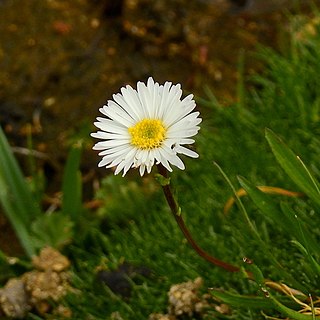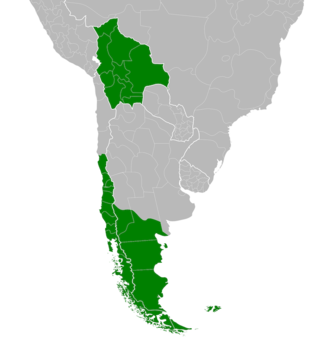
Pedro Aguirre Cerda is a commune of Chile located in Santiago Province, Santiago Metropolitan Region. It is named after President Pedro Aguirre Cerda.

Peñalolén is a Chilean commune in Santiago Province, Santiago Metropolitan Region. It was founded on 15 November 1984.

Pudahuel is a commune of Chile located in Santiago Province, Santiago Metropolitan Region. Santiago's international airport Arturo Merino Benítez is located there.

Quinta Normal is a commune of Chile located in Santiago Province, Santiago Metropolitan Region. It is named after a large park in the area.

Renca is a commune of Chile located in Santiago Province, Santiago Metropolitan Region. It was founded on 6 May 1894.
San Joaquín is a commune of Chile located in Santiago Province, Santiago Metropolitan Region. It is part of Greater Santiago.

Copiapó is a city and commune in northern Chile, located about 65 kilometers east of the coastal town of Caldera. Founded on December 8, 1744, it is the capital of Copiapó Province and Atacama Region.

The Chonos Archipelago is a series of low, mountainous, elongated islands with deep bays, traces of a submerged Chilean Coast Range. Most of the islands are forested with little or no human settlement. The deep Moraleda Channel separates the islands of the Chonos Archipelago from the mainland of Chile and from Magdalena Island.
Serranía de la Macarena is an isolated mountain range located in the Meta Department, Colombia. It was named after the Virgin of Hope of Macarena. The mountains are separated by about 40 km (25 mi) at their northern extreme from the East Andes. The range is orientated from north to south and is 120 km (75 mi) in length and 30 km (19 mi) wide. The highest peak reaches 2,615 m (8,579 ft) and is the highest point of the Orinoquía Region. The first national reserve in Colombia was established in the central part of the mountain range in accordance with a Congressional Law promulgated in 1948. The status of National Natural Park was designated in 1971 and the protected area encompasses 6,200 km2 (2,400 sq mi).

Pfaffia glomerata is a medicinal plant native to Argentina, Bolivia, Cerrado, and Pantanal vegetation in Brazil.

Donatia is a genus of two cushion plant species in the family Stylidiaceae. The name commemorates Vitaliano Donati, an Italian botanist.

Los Chiles is a canton in the Alajuela province of Costa Rica.

Donatia fascicularis is a species of cushion plant in the family Donatiaceae and is closely related to species in the family Stylidiaceae. It is found in the alpine and subalpine regions of western Patagonia and Tierra del Fuego. It is the type species of the genus Donatia J.R. Forst. & G. Forst.
Oreobolus obtusangulus is a thick cushion grass native to South America. It grows in the highlands of Colombia and Venezuela, alpine wetlands of Central Chile and Neuquén Province of Argentina. Further south it grows at lower elevations including Tierra del Fuego and Falkland Islands. Oreobolus obtusangulus grows in parts of Patagonia that were glaciated during the last glaciation, a genetic study suggest that the survived glaciation in three separate glacial refugia; these being south-central Chile, the eastern Patagonian Andes and eastern Tierra del Fuego.

Symphyotrichum glabrifolium is a species of flowering plant in the family Asteraceae native to Argentina and Chile where it inhabits wet meadows and stream edges. It is a perennial, herbaceous plant that grows 5 to 25 centimeters tall. Its flowers have white or lilac ray florets and yellow disk florets.

Symphyotrichum peteroanum is a species of flowering plant in the family Asteraceae endemic to Argentina and Chile. It is a perennial, herbaceous plant that grows 20 to 60 centimeters tall. Its flowers have white ray florets in one series that are 6–8 millimeters long. It grows in tall forests with trees that exceed 15 meters at elevations of 1,000–2,200 meters in humid montane ecosystems.

Symphyotrichum vahlii is a species of flowering plant in the family Asteraceae native to South America, specifically Bolivia, Chile, Argentina, and the Falkland Islands. It is herbaceous and grows 10 to 60 centimeters tall. Its flowers have white ray florets of length 6 millimeters. It grows in wetland areas of tall forests with trees that exceed 15 meters. One infraspecies is accepted, Symphyotrichum vahlii var. tenuifolium, in addition to the autonym S. vahlii var. vahlii.

The Añana Diapir is a diapir in Álava, Basque Country, Spain. Two notable wetlands are located within the diapir: the Salt Valley of Añana and Lake Arreo. It was declared a protected biotope by the Basque Government in 2016.















